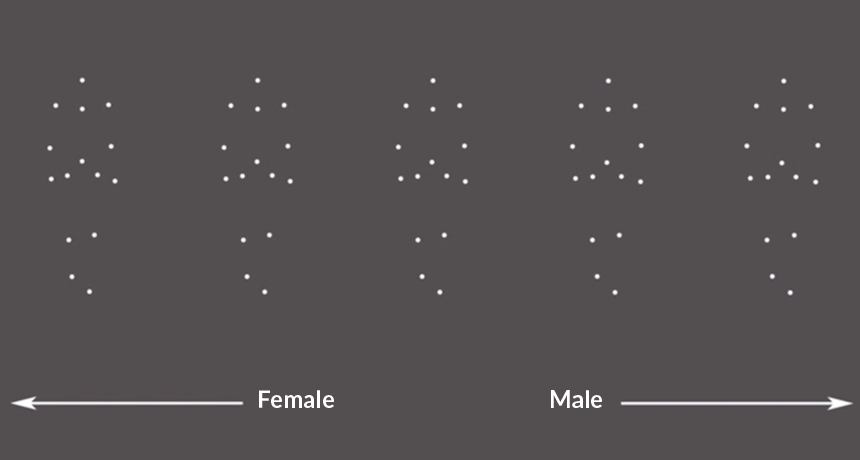Humans can sniff out gender
Study adds to controversy of whether people have pheromones

GENDER BENDER Steroids found in men’s sweat and women’s urine may alter how people perceive gender. Sniffing the steroids influences how people describe walking dot figures (with gaits ranging from feminine at left to masculine at right).
W. Zhou et al/Current Biology 2014
Just a whiff of a man’s armpit could reveal his gender — to people attracted to males, at least. And females’ urine could offer men and lesbians the telltale scent of a woman, according to a controversial new study of how bodily secretions tweak perceptions.
“Our findings argue for the existence of human sex pheromones,” says olfaction researcher Wen Zhou of the Chinese Academy of Sciences in Beijing.
Pheromones are chemical signals that some animals use to convey information about sex, health and predators. Their existence and effect on behavior are well documented in reptiles, rodents and other animals but not clear-cut in humans. People lack the sensory equipment other animals use to detect these cues.
Still, human bodies churn out chemicals similar to those that act as pheromones in animals, Zhou says. A compound in male pigs’ saliva prompts female pigs in heat to assume a mating position, she says. Researchers have previously shown that smelling the human version of this chemical, androstadienone, a steroid found in semen and men’s armpit sweat and hair, boosts women’s moods and heart rates. Some scientists have also reported a similar mood improver for men: an estrogen-like compound in women’s urine called estratetraenol.
WALK LIKE A MAN The perceived gender (female, left; male, right) of dot figures walking on a screen changes when women and men sniff steroids secreted in male armpit sweat and female urine.W. Zhou et al/Current Biology 2014 |
But no one knew if these steroids also passed along sexual information about people, Zhou says. She and colleagues recruited 48 men and 48 women, half of them gay or bisexual. The volunteers continuously inhaled concentrated hits of either of the two steroids, which were both scented to smell like cloves, while watching videos of one of seven walking figures. Though the figures, just 15 dots suggesting the shape of a person, didn’t look like men or women, their gaits ranged from feminine — with swaying hips — to neutral to masculine.
When heterosexual men sniffed the female steroid, compared with the male steroid or the clove scent alone, they were more likely to judge the figures as female, Zhou and colleagues report May 1 in Current Biology. And when heterosexual women breathed in the male steroid, they tended to call the figures male.
What’s more, gay men responded to the male steroid just like heterosexual women did, and lesbian or bisexual women behaved like the heterosexual men.
“The nose can detect people of the gender one is attracted to,” Zhou says.
But some scientists aren’t convinced. “The notion of human pheromones is fraught with problems,” says Richard Doty, director of the Smell and Taste Center at the University of Pennsylvania in Philadelphia. One major concern, he says, is that the steroids may not actually be present in human hair or excretions at high enough levels to be detected.
Zhou and colleagues acknowledge that the steroids’ effects in everyday life would be smaller than those the researchers observed in the lab.
Ideally, researchers need to show exactly how purported pheromones work in humans, says neurobiologist Emily Liman of the University of Southern California in Los Angeles.
“We need to know the specific parts of the anatomy that respond to pheromones,” she says. “We have to move from the psychological to the biological.”






